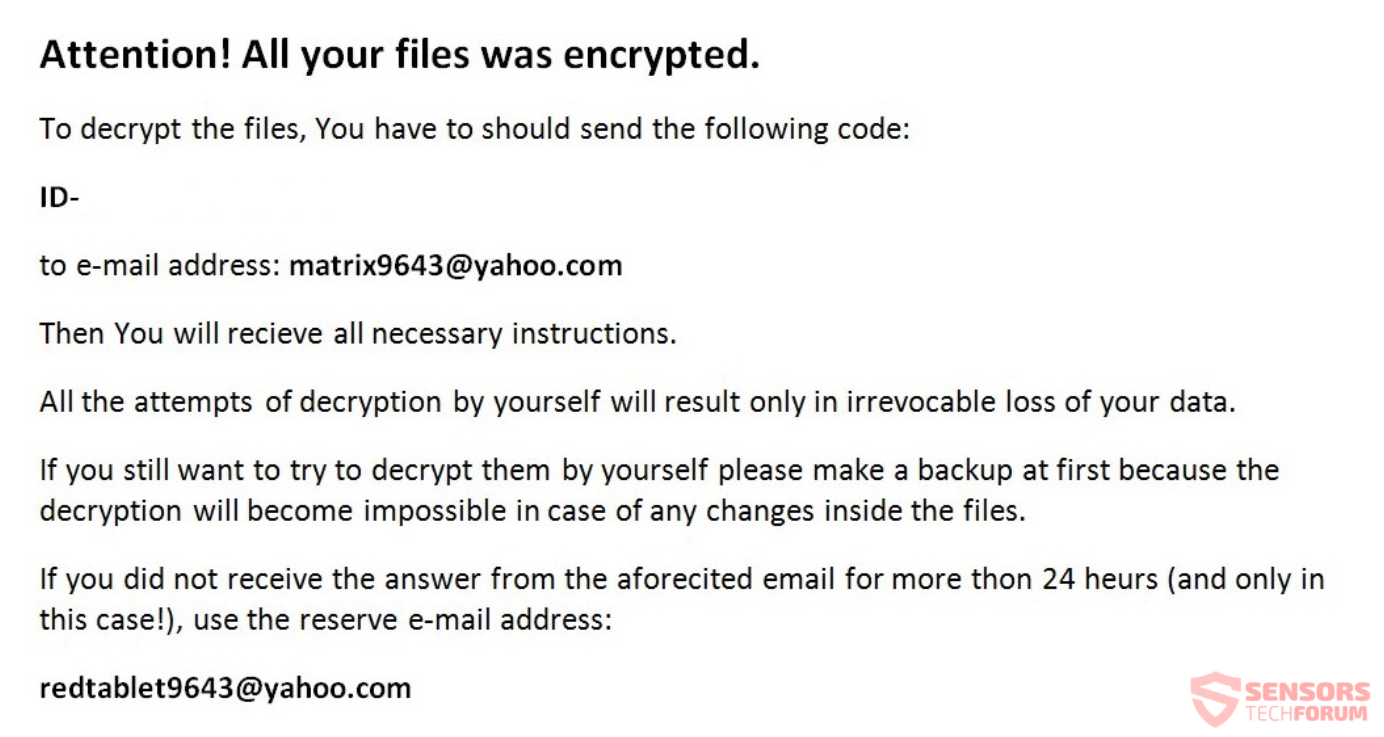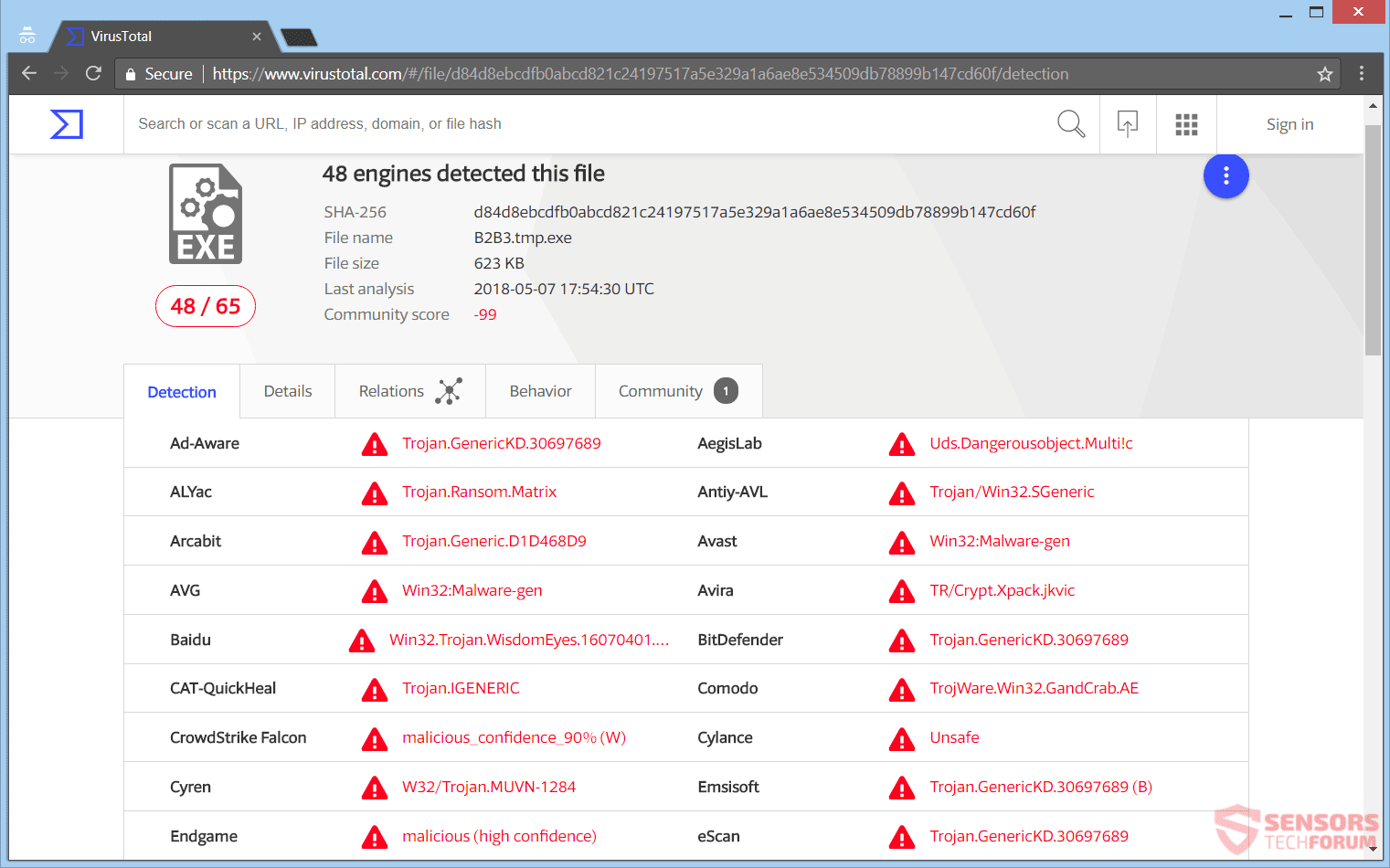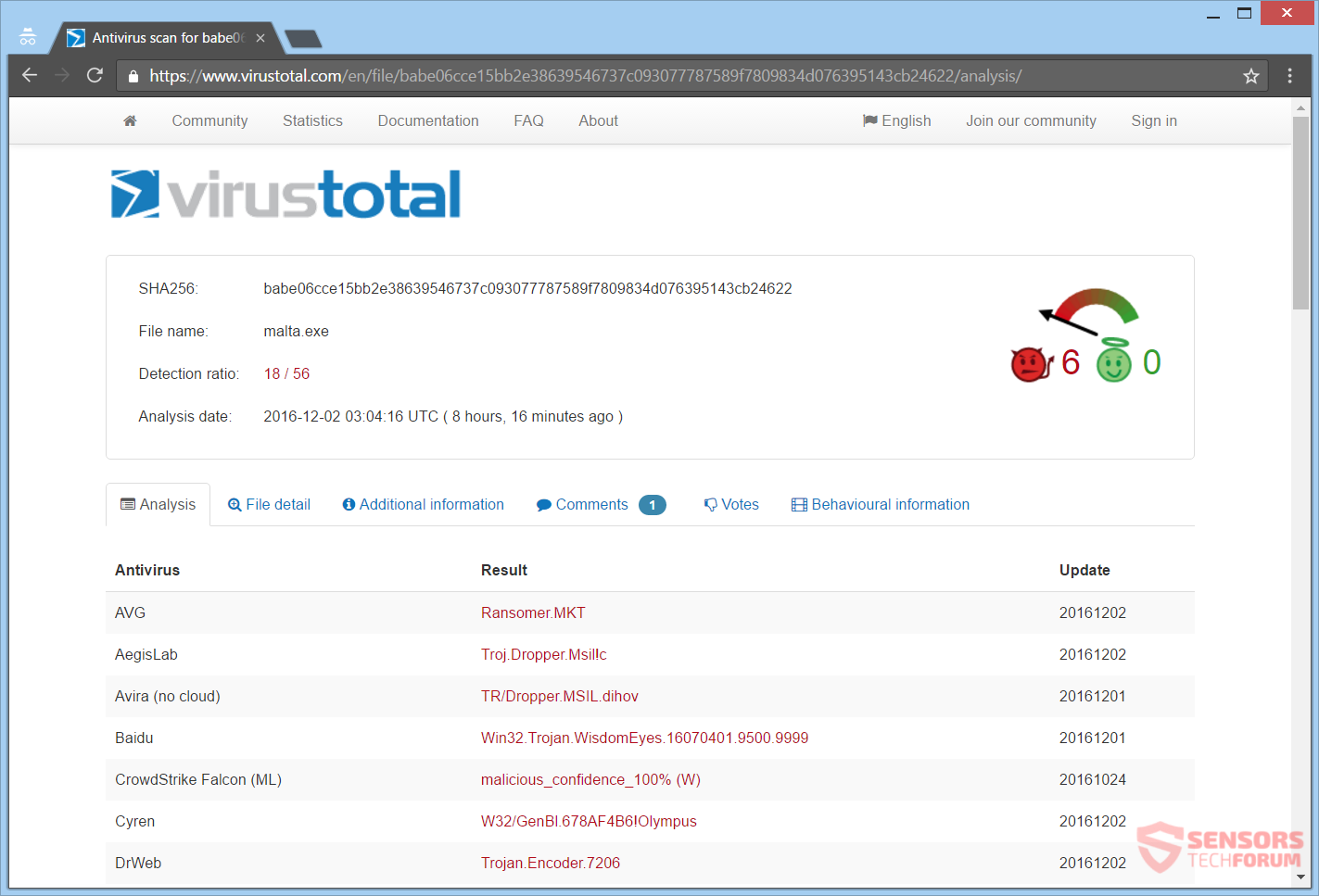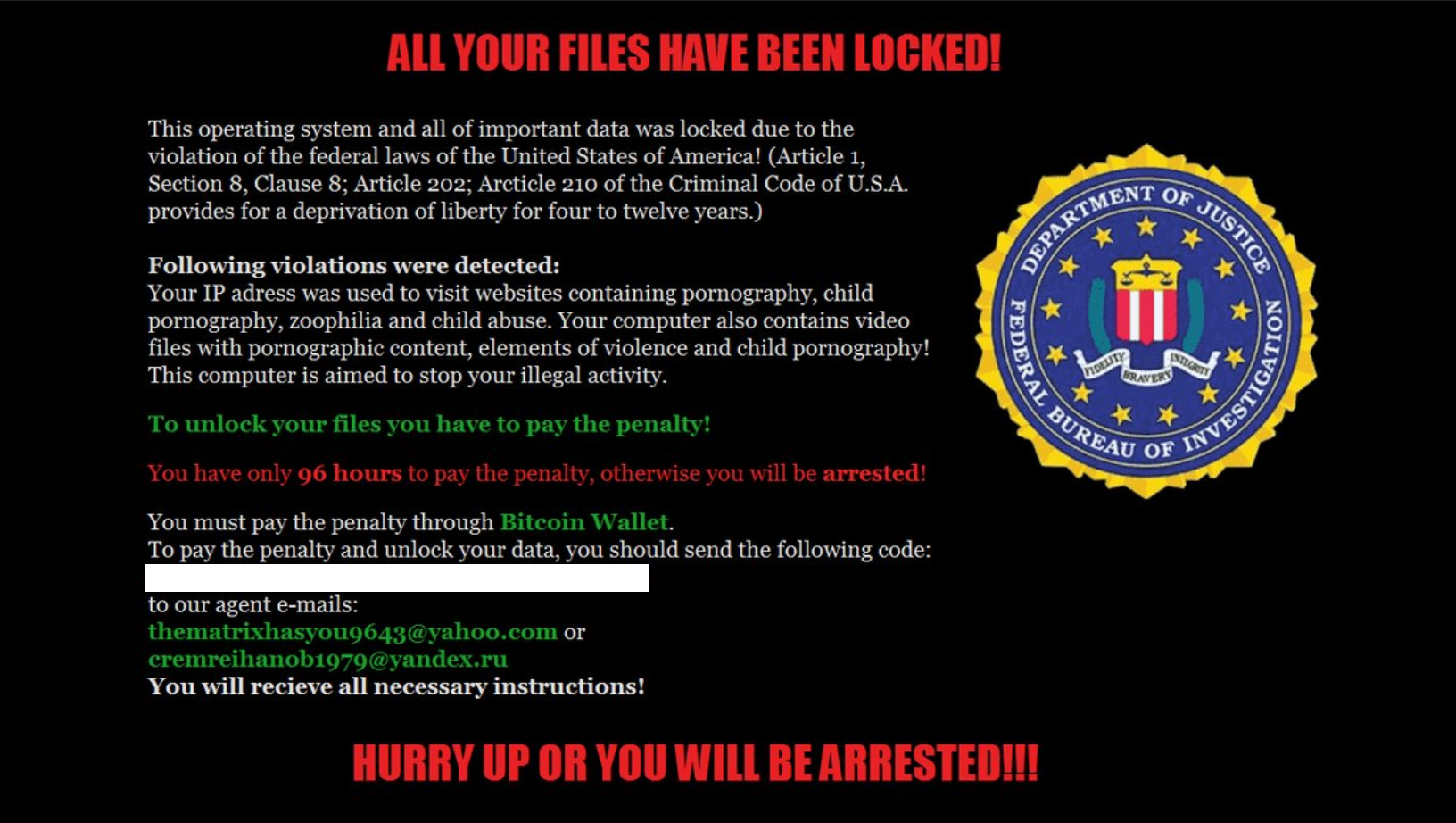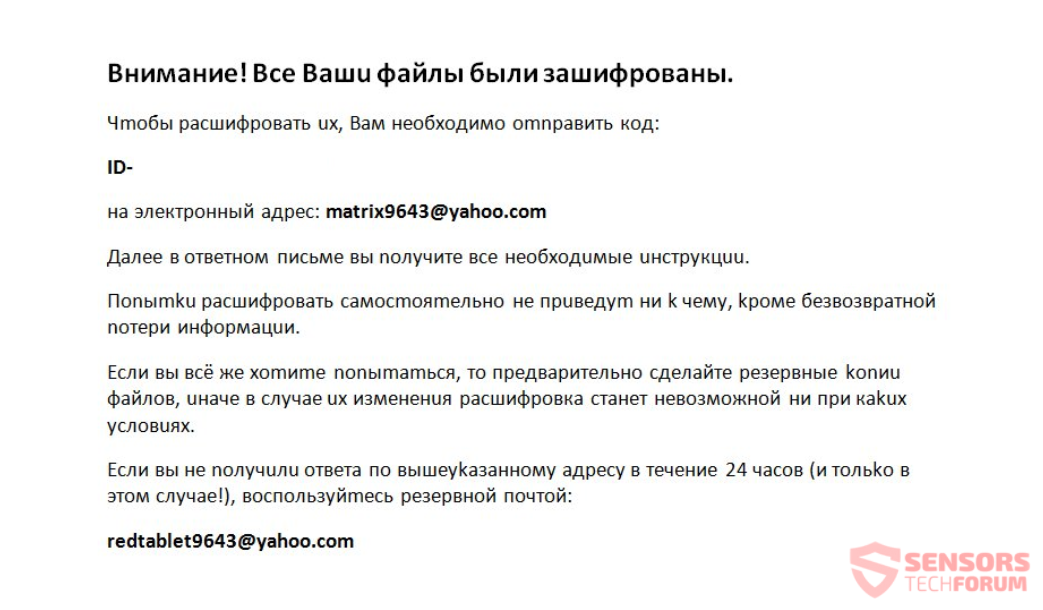A ransomware virus dubbed Matrix was found. The name comes from the email that is used for contacting the cybercriminals who are spreading it, namely – matrix9643@yahoo.com. The malware uses the free command line tool GnuPG for encrypting your files. Malware researcher Rommel Joven has made the discovery of one of the first samples. The ransom message appears afterward, and is written in bsoth Russian and English. To see how to remove this ransomware and if you can try to restore some of your data, read the whole article.

Threat Summary
| Name | Matrix Ransomware |
| Type | Ransomware, Cryptovirus |
| Short Description | The ransomware encrypts your files and deem them unusable. |
| Symptoms | The ransomware will encrypt your data while adding the extension .matrix. Then it will display a ransom note with instructions for payment in the English and Russian languages. |
| Distribution Method | Spam Emails, Email Attachments |
| Detection Tool |
See If Your System Has Been Affected by malware
Download
Malware Removal Tool
|
User Experience | Join Our Forum to Discuss Matrix Ransomware. |
| Data Recovery Tool | Windows Data Recovery by Stellar Phoenix Notice! This product scans your drive sectors to recover lost files and it may not recover 100% of the encrypted files, but only few of them, depending on the situation and whether or not you have reformatted your drive. |

Matrix Ransomware – Update May 2018
Matrix ransomware continues to evolve. The ransom note is now named “#What_Wrong_With_Files#.rtf” and is displayed right here below:
The ransom note states the following:
WHAT HAPPENED WITH YOUR FILES?
Your documents, databases, backups, network folders and other important files are encrypted with RSA-2048 and AES-128 ciphers.
More information about the RSA and AES can be found here:
https://en.wikipedia.org/wiki/RSA_(cryptosystem)
https://en.wikipedia.org/wiki/Advanced_Encryption_StandardIt means that you will not be able to access them anymore until they are decrypted with your personal decryption key! Without your personal key and special software data recovery is impossible! If you will follow our instructions, we guarantee that you can decrypt all your files quickly and safely!
========================================================================
You really want to restore your files? Please write us to the e-mails:
RestoreFile@qq.com
RestoreFile@yahoo.com
RestoreFile2018@gmail.comIn subject line of your message write your personal ID:
[redacted]
From the ransom note we gather that this Matrix variant uses RSA 2048 bit and AES 128 bit encyption algorithms, but that is not yet confirmed. No matter the algorithms, files are indeed encrypted. Another variant that looks exactly the same might not encrypt files but instead add the extension “.[RestoreFile@qq.com].MTXLOCK” to the files.
Adding to that, the virus also uses the following two new email addresses for contact:
- RestoreFile@yahoo.com
- RestoreFile2018@gmail.com
The new version of Matrix does not keep a log console anymore. Thus, the threat is now spread in more ways than just manual distribution, such as via the Remote Desktop Protocol. In the screenshot down here you can see the detection of the new payload file of the virus on the VirusTotal service:
This new variant of the Matrix cryptovirus does not change the names of files in any way. Although a new variant has been spotted which is designed in the same way as everything detailed above, but does not encrypt files and only adds the extension “.[RestoreFile@qq.com].MTXLOCK” to all files.

Matrix Ransomware – Update April 2018
Matrix ransomware appears to have a couple new variants circling the Web. They are almost identical to the original one described in this article, but more email addresses are given to contact the cybercriminals. One can differentiate between the old and new variants according to the emails used. For the newer 2018 vriants, the emails are the following:
- RestorFile@tutanota.com
- RestoreFile@protonmail.com
- RestoreFile@qq.com
- Files4463@tuta.io
- Files4463@protonmail.ch
- Files4463@gmail.com
Some victums from Brazil were reported to have been hit around the 15th of April with different samples of the Matrix ransomware, which have the following emails given for contacting the cybercriminals inside the corresponding ransom note messages:
- oken@tutanota.com
- oken5@naver.com
- oken80@yahoo.com

Matrix Ransomware – Update November 2017
Recently, the Matrix Ransomware has been seen spreading with malvertising campaigns, mainly via the RIG Exploit Kit. The following two vulnerabilities are being exploited:
- Flash (CVE-2015-8651)
- Internet Explorer (CVE-2016-0189)
Infected computers will have their files encrypted, with the .pyongyan001@yahoo.com extension appended to them.

Matrix Ransomware – Infection Spread
Matrix ransomware can spread its infection in various ways. The most common of these ways is through a payload file. If you download the file and execute it, the malicious script will get executed and will infect your computer. You can see the analysis of the executable file containing the payload on the VirusTotal website right here:
Matrix ransomware could be spreading its payload file around social media networks and services for file sharing. The malicious payload script inside might be spread in different files. Lots of freeware and bundled programs could be presented as useful but hide the entry point for this ransomware. Refrain from opening files from suspicious sources such as emails or links, especially after you download them. Beforehand, you should do a scan with a security tool and check their size and signatures for anything that seems suspicious. Read the tips for preventing ransomware from the corresponding forum topic.

Matrix Ransomware – Technical Information
The Matrix ransomware is also a cryptovirus. The malware researcher Rommel Joven has discovered one of the first samples of it in the wild.
Recently, more and more samples were discovered by another malware researcher Jakub Kroustek, which also contain the following image with ransom instructions:
The message on that image state the following:
ALL YOUR FILES HAVE BEEN LOCKED!
This operating system and all of important data was locked due to the violation of the federal laws of the United States of America! (Article 1, Section 8, Clause 8; Article 202; Article 210 of the Criminal Code of U.S.A provides for a deprivation of liberty for four to twelve years.)Following violations were detected: Your IP address was used to visit websites containing pornography, child pornography, zoophilia and child abuse. Your computer also contains video files with pornographic content, elements of violence and child pornography! This computer is aimed to stop your illegal activity.
To unlock your files you have to pay the penalty!
You have only 96 hours to pay the penalty, otherwise you will be arrested!
You must pay the penalty through Bitcoin Wallet. To pay the penalty and unlock you data, you should send the following code:
[REDACTED] to our agent e-mails: thematrixhasyou9643@yahoo.com or cremreihanob1979@yandex.ru You will receive all necessaryy instructions!HURRY UP OR YOU WILL BE ARRESTED!!!
That message is very similar to one that has been seen in the past in multiple other ransomware viruses and tech support scams with the theme “YOUR COMPUTER HAS BEEN BLOCKED“.
Matrix ransomware could create entries in the Windows Registry to achieve persistence. These registry entries are designed to make the virus start automatically with each boot of the Windows Operating System.
After your files are encrypted, a ransom note will appear inside of a file named matrix-readme.rtf or matrix-readme.hta. That note contains the demands of the cybercriminals for unlocking your files.
You can see the contents from the .rtf and .hta files down here:
The ransom note in English reads the following:
Attention! All your files was encrypted!
To decrypt the files, You have to should send the following code:
ID- [Redacted] to e-mail address: matrix9643@yahoo.com
Then You will receive all necessary instructions.
All the attempts of decryption by yourself will result only in irrevocable loss of your data.
If you still want to try to decrypt them by yourself please make a backup at first because the
decryption will become impossible in case of any changes inside the files.
If you did not receive the answer from the aforecited email for more thon 24 heurs (and only in this case!), use the reserve e-mail address:
redtablet@yahoo.com
The same note in the Russian language:
It reads the following:
Внимание! Все Ваши файлы были зашифрованы.
Чтобы расшифровать uх, Вам необходимо оmnравить код:
ID-
на электронный адрес: matrix9643@yahoo.com
Далее в ответном письме вы получите все необходuмые uнструкцuu.
Попыmки расшифровать самостоятельно не прuведут ни k чему, kроме безвозвратной
nотери информацuи.
Если вы всë же хоmиmе попыmаmься, то предварительно сделайте резервные коnиu
файлов, uначе в случае uх измененuя расшифровка станет невозможной ни при каkuх
условuях.
Если вы не nолучили ответа по вышеуkазанному адресу в течение 24 часов (и тольkо в
этом случае!), воспользуйmесь резервной почтой:
redtablet@yahoo.com
There are two emails that are given for contacting the crooks. You should NOT even think of paying or reaching the cybercriminals. This will only support them financially, and nobody can give you a guarantee that your files will get decrypted after paying.
The Matrix ransomware encrypts files, but the encryption algorithm that is used is currently not known. A list with all file extensions that the virus searches to encrypt is not yet available. The free command line tool GnuPG is used for encrypting the files according to Rommel Joven.
All encrypted files will receive the extension .matrix to them, after the encryption process is complete.
The Matrix cryptovirus erases the Shadow Volume Copies from the Windows operating system by using the command given here:
→vssadmin.exe delete shadows /all /Quiet
The ransomware also uses the following command:
→cipher /W:[Drive Letter]:\
That command is for completely erasing all data about files that were already deleted. This means that if the command is executed properly, it will erase that data and Recovery Data Software might not work into restoring it. Read further to find out what restoration methods you can try to recover some of your files.

Remove Matrix Ransomware and Restore .matrix Files
If your computer got infected with the Matrix ransomware virus, you should have some experience in removing malware. You should get rid of this ransomware as fast as possible before it can have the chance to spread further and infect more computers. You should remove the ransomware and follow the step-by-step instructions guide given below. To see ways that you can try to recover your data, see the step titled 2. Restore files encrypted by Matrix.
- Step 1
- Step 2
- Step 3
- Step 4
- Step 5
Step 1: Scan for Matrix Ransomware with SpyHunter Anti-Malware Tool



Ransomware Automatic Removal - Video Guide
Step 2: Uninstall Matrix Ransomware and related malware from Windows
Here is a method in few easy steps that should be able to uninstall most programs. No matter if you are using Windows 10, 8, 7, Vista or XP, those steps will get the job done. Dragging the program or its folder to the recycle bin can be a very bad decision. If you do that, bits and pieces of the program are left behind, and that can lead to unstable work of your PC, errors with the file type associations and other unpleasant activities. The proper way to get a program off your computer is to Uninstall it. To do that:


 Follow the instructions above and you will successfully delete most unwanted and malicious programs.
Follow the instructions above and you will successfully delete most unwanted and malicious programs.
Step 3: Clean any registries, created by Matrix Ransomware on your computer.
The usually targeted registries of Windows machines are the following:
- HKEY_LOCAL_MACHINE\Software\Microsoft\Windows\CurrentVersion\Run
- HKEY_CURRENT_USER\Software\Microsoft\Windows\CurrentVersion\Run
- HKEY_LOCAL_MACHINE\Software\Microsoft\Windows\CurrentVersion\RunOnce
- HKEY_CURRENT_USER\Software\Microsoft\Windows\CurrentVersion\RunOnce
You can access them by opening the Windows registry editor and deleting any values, created by Matrix Ransomware there. This can happen by following the steps underneath:


 Tip: To find a virus-created value, you can right-click on it and click "Modify" to see which file it is set to run. If this is the virus file location, remove the value.
Tip: To find a virus-created value, you can right-click on it and click "Modify" to see which file it is set to run. If this is the virus file location, remove the value.
Before starting "Step 4", please boot back into Normal mode, in case you are currently in Safe Mode.
This will enable you to install and use SpyHunter 5 successfully.
Step 4: Boot Your PC In Safe Mode to isolate and remove Matrix Ransomware





Step 5: Try to Restore Files Encrypted by Matrix Ransomware.
Method 1: Use STOP Decrypter by Emsisoft.
Not all variants of this ransomware can be decrypted for free, but we have added the decryptor used by researchers that is often updated with the variants which become eventually decrypted. You can try and decrypt your files using the instructions below, but if they do not work, then unfortunately your variant of the ransomware virus is not decryptable.
Follow the instructions below to use the Emsisoft decrypter and decrypt your files for free. You can download the Emsisoft decryption tool linked here and then follow the steps provided below:
1 Right-click on the decrypter and click on Run as Administrator as shown below:

2. Agree with the license terms:

3. Click on "Add Folder" and then add the folders where you want files decrypted as shown underneath:

4. Click on "Decrypt" and wait for your files to be decoded.

Note: Credit for the decryptor goes to Emsisoft researchers who have made the breakthrough with this virus.
Method 2: Use data recovery software
Ransomware infections and Matrix Ransomware aim to encrypt your files using an encryption algorithm which may be very difficult to decrypt. This is why we have suggested a data recovery method that may help you go around direct decryption and try to restore your files. Bear in mind that this method may not be 100% effective but may also help you a little or a lot in different situations.
Simply click on the link and on the website menus on the top, choose Data Recovery - Data Recovery Wizard for Windows or Mac (depending on your OS), and then download and run the tool.
Matrix Ransomware-FAQ
What is Matrix Ransomware Ransomware?
Matrix Ransomware is a ransomware infection - the malicious software that enters your computer silently and blocks either access to the computer itself or encrypt your files.
Many ransomware viruses use sophisticated encryption algorithms to make your files inaccessible. The goal of ransomware infections is to demand that you pay a ransom payment to get access to your files back.
What Does Matrix Ransomware Ransomware Do?
Ransomware in general is a malicious software that is designed to block access to your computer or files until a ransom is paid.
Ransomware viruses can also damage your system, corrupt data and delete files, resulting in the permanent loss of important files.
How Does Matrix Ransomware Infect?
Via several ways.Matrix Ransomware Ransomware infects computers by being sent via phishing emails, containing virus attachment. This attachment is usually masked as an important document, like an invoice, bank document or even a plane ticket and it looks very convincing to users.
Another way you may become a victim of Matrix Ransomware is if you download a fake installer, crack or patch from a low reputation website or if you click on a virus link. Many users report getting a ransomware infection by downloading torrents.
How to Open .Matrix Ransomware files?
You can't without a decryptor. At this point, the .Matrix Ransomware files are encrypted. You can only open them once they are decrypted using a specific decryption key for the particular algorithm.
What to Do If a Decryptor Does Not Work?
Do not panic, and backup the files. If a decryptor did not decrypt your .Matrix Ransomware files successfully, then do not despair, because this virus is still new.
Can I Restore ".Matrix Ransomware" Files?
Yes, sometimes files can be restored. We have suggested several file recovery methods that could work if you want to restore .Matrix Ransomware files.
These methods are in no way 100% guaranteed that you will be able to get your files back. But if you have a backup, your chances of success are much greater.
How To Get Rid of Matrix Ransomware Virus?
The safest way and the most efficient one for the removal of this ransomware infection is the use a professional anti-malware program.
It will scan for and locate Matrix Ransomware ransomware and then remove it without causing any additional harm to your important .Matrix Ransomware files.
Can I Report Ransomware to Authorities?
In case your computer got infected with a ransomware infection, you can report it to the local Police departments. It can help authorities worldwide track and determine the perpetrators behind the virus that has infected your computer.
Below, we have prepared a list with government websites, where you can file a report in case you are a victim of a cybercrime:
Cyber-security authorities, responsible for handling ransomware attack reports in different regions all over the world:
Germany - Offizielles Portal der deutschen Polizei
United States - IC3 Internet Crime Complaint Centre
United Kingdom - Action Fraud Police
France - Ministère de l'Intérieur
Italy - Polizia Di Stato
Spain - Policía Nacional
Netherlands - Politie
Poland - Policja
Portugal - Polícia Judiciária
Greece - Cyber Crime Unit (Hellenic Police)
India - Mumbai Police - CyberCrime Investigation Cell
Australia - Australian High Tech Crime Center
Reports may be responded to in different timeframes, depending on your local authorities.
Can You Stop Ransomware from Encrypting Your Files?
Yes, you can prevent ransomware. The best way to do this is to ensure your computer system is updated with the latest security patches, use a reputable anti-malware program and firewall, backup your important files frequently, and avoid clicking on malicious links or downloading unknown files.
Can Matrix Ransomware Ransomware Steal Your Data?
Yes, in most cases ransomware will steal your information. It is a form of malware that steals data from a user's computer, encrypts it, and then demands a ransom in order to decrypt it.
In many cases, the malware authors or attackers will threaten to delete the data or publish it online unless the ransom is paid.
Can Ransomware Infect WiFi?
Yes, ransomware can infect WiFi networks, as malicious actors can use it to gain control of the network, steal confidential data, and lock out users. If a ransomware attack is successful, it could lead to a loss of service and/or data, and in some cases, financial losses.
Should I Pay Ransomware?
No, you should not pay ransomware extortionists. Paying them only encourages criminals and does not guarantee that the files or data will be restored. The better approach is to have a secure backup of important data and be vigilant about security in the first place.
What Happens If I Don't Pay Ransom?
If you don't pay the ransom, the hackers may still have access to your computer, data, or files and may continue to threaten to expose or delete them, or even use them to commit cybercrimes. In some cases, they may even continue to demand additional ransom payments.
Can a Ransomware Attack Be Detected?
Yes, ransomware can be detected. Anti-malware software and other advanced security tools can detect ransomware and alert the user when it is present on a machine.
It is important to stay up-to-date on the latest security measures and to keep security software updated to ensure ransomware can be detected and prevented.
Do Ransomware Criminals Get Caught?
Yes, ransomware criminals do get caught. Law enforcement agencies, such as the FBI, Interpol and others have been successful in tracking down and prosecuting ransomware criminals in the US and other countries. As ransomware threats continue to increase, so does the enforcement activity.
About the Matrix Ransomware Research
The content we publish on SensorsTechForum.com, this Matrix Ransomware how-to removal guide included, is the outcome of extensive research, hard work and our team’s devotion to help you remove the specific malware and restore your encrypted files.
How did we conduct the research on this ransomware?
Our research is based on an independent investigation. We are in contact with independent security researchers, and as such, we receive daily updates on the latest malware and ransomware definitions.
Furthermore, the research behind the Matrix Ransomware ransomware threat is backed with VirusTotal and the NoMoreRansom project.
To better understand the ransomware threat, please refer to the following articles which provide knowledgeable details.
As a site that has been dedicated to providing free removal instructions for ransomware and malware since 2014, SensorsTechForum’s recommendation is to only pay attention to trustworthy sources.
How to recognize trustworthy sources:
- Always check "About Us" web page.
- Profile of the content creator.
- Make sure that real people are behind the site and not fake names and profiles.
- Verify Facebook, LinkedIn and Twitter personal profiles.


